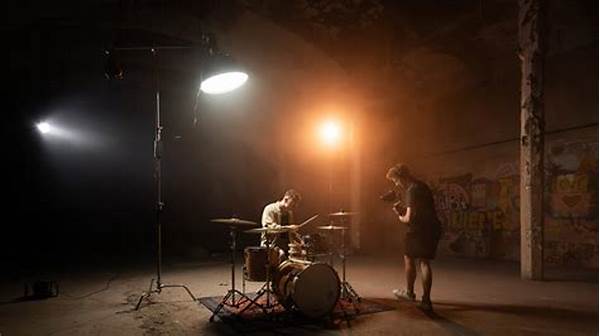Hey there! Ever wonder why horror movies or haunted houses always manage to freak us out, even if we’re not alone? Well, a lot of the credit goes to the clever use of lighting techniques. Yep, those eerie shadows and spine-chilling highlights aren’t accidents. They’re meticulously crafted to make your hair stand on end. Today, let’s dive into the intriguing world of lighting techniques in horror environments and see how these cunning tricks pull you right into the world of macabre.
Read Now : Algorithm-based Animation Procedural Systems
Creating the Atmosphere: The Essence of Horror Lighting
So, let’s get started on how lighting techniques in horror environments pull us right into that eerie atmosphere. Imagine walking down a dimly lit hallway, shadows creeping from every corner, and a soft but unsettling flicker from a distant bulb. Feels creepy, right? That’s the magic of lighting working its charm—or curse! In horror, lighting is not just about illuminating a scene. It plays with our psychological responses, heightening our sense of fear and anticipation.
Horror lighting often uses low-key lighting to shroud much of the screen in darkness. This amplifies suspense by making us focus on what’s being lit—or more hauntingly, what isn’t. The strategic placement of lights creates stark contrasts and unsettling shapes, fooling our brains into expecting something sinister. In fact, these lighting techniques in horror environments are designed to mess with our instincts, playing on our fear of the unknown lurking just beyond our sight.
Another trick of the trade? Colour, or the lack thereof. A lot of horror environments use desaturated colours, mirroring the bleakness of the scenario. Occasionally, a stark red or a sickly green is thrown into the mix, adding a visual jolt. It’s fascinating to see how these choices, subtle as they may be, have us gripping our seats tighter, eyes darting from shadow to shadow. And that’s exactly why the art of lighting remains one of the most essential elements in creating unforgettable horror experiences.
Key Lighting Techniques in Horror Setting Explained
1. Chiaroscuro: This technique employs high contrast between light and dark areas. It’s a staple in horror, transforming ordinary spaces into sinister setups by highlighting deviant features, thus layering suspense.
2. Silhouettes: Utilized to show outlines or figures without detail, silhouettes fuel imagination and unease. The unknown can be more terrifying than the visible, a classic in lighting techniques in horror environments.
3. Flickering Lights: Ever notice how flickering bulbs just scream “DANGER”? They create a rhythm of expectation, allowing fear to seep into moments that seem mundane, keeping tension alive.
4. Underlighting: Illuminating a subject from below creates an unnatural and eerie look. Horror filmmakers exploit this quirkiness to turn ordinary elements into grotesque figures.
5. Colored Gels: Use of tinted lighting like reds and blues adds texture to horror scenes. It plays with emotional reactions, setting the mood for what’s lurking in the shadows. These lighting techniques in horror environments can drastically change the scene’s emotional impact.
The Psychological Impact: Dive Deeper into Horror Lighting
Okay, so we know lighting techniques in horror environments are all about mood and atmosphere. But why do these elements affect us so profoundly? One word: psychology. Human brains are wired to react instinctively to light and shadow. Darkness suggests danger, the unknown lurking, while light is supposed to bring safety. Horror lighting techniques flip this innate understanding, making light a tool of fear rather than comfort.
Think about those moments when a scene is drenched in dynamic shadows. Our brains attempt to fill in the gaps, promoting anxiety and dread as we anticipate a jump scare or a lurking monster. It’s a sensory trick that makes even seasoned horror fans jump out of their seats. Another cool trick? The sudden switch from light to darkness—or vice versa. This sudden shift disturbs our visual stability and heightens suspense, tapping into our primal fear responses.
By using these lighting techniques, filmmakers create a powerful narrative without uttering a single word. It’s fascinating yet freaky how light alone can guide our emotions, manipulating them to serve the story’s dreadful needs. So, next time you’re caught up in a spine-chilling moment onscreen, remember: it’s the lighting doing the heavy lifting, artfully nudging your fears to the forefront.
Techniques Galore: An Array of Horror Lighting Tricks
1. Spotlighting: By focusing light on specific elements, everything else fades into darkness, creating drama and drawing attention to potential threats.
2. Backlighting: Creates ominous silhouettes and an ethereal halo effect, rendering figures otherworldly and unnerving when applied in horror scenes.
3. Gobo Lighting: Textured effects and shapes are projected onto surfaces, crafting illusionary spaces and shadows that play with our sense of what is and isn’t real.
4. Practical Lighting: Using on-set lights like lamps or candles for a more ‘real’ feel. Lighting techniques in horror environments often use them to ground fantasy elements in reality.
5. Strobe Lighting: Sharp bursts of light create disorienting effects, charging the atmosphere with manic energy, often sparking a cascade of frantic movements on screen.
Read Now : Flexible Game Asset Integration
6. Ambient Lighting: Subtle yet essential for setting the mood. It forms the baseline atmosphere, enhanced by other dynamic lighting choices.
7. Diegetic Lighting: Visible light sources within the film, like fireplace or moonlight, elevate authenticity, embedding chilling realism within supernatural settings.
8. Motivated Lighting: Creates specific lighting effects tied to narrative elements. For example, stormy nights lead to brilliant lightning flashes that underscore drama.
9. Unmotivated Lighting: Eschews realism and logic; uses unnatural sources, like a mysterious glow. This is where lighting techniques in horror environments thrive by shocking viewers into awe and terror.
10. Slimelight: Bright beams narrow focus on key elements. Perfect for those jump-scare moments, revealing ghastly details amidst engulfing darkness.
The Evolution of Horror Lighting: Where It’s Headed
You might wonder how lighting techniques in horror environments have evolved and where they are headed next. Interestingly, as technology marches on, so do these techniques. Just consider how digital tools allow us to simulate natural lighting digitally, expanding directors’ creativity in crafting unsettling scenes. It opens up a freaky world of new possibilities with visual precision, optimizing fear factors while retaining emotional heft.
The blend of old-school practical effects with modern computer-generated lighting marks a new era in horror filmmaking. From ghastly ghosts emerging from digital shadows to hyper-realistic gore that pushes viewer’s comfort zones, today’s horror films capitalize on these advances. LED lighting has made it easier to manipulate colors and hues, setting specific moods without a fuss. Whether it’s vintage noir influences or futuristic horror aesthetics, lighting remains pivotal in stirring visceral reactions from audiences.
The best part? As filmmakers push creativity to its limits, new generations of horror streamers and lovers will continue to appreciate the nuanced artistry of these lighting techniques in horror environments. From delightfully tense tension-building scenes to ethereal fear-inducing moments, lighting will always be there, ready to sweep you off—and probably chill—your feet. So, keep your eyes peeled; the shadows are always lurking, waiting to tell the next dark tale.
Understanding the Role of Lighting in Horror
Lighting is one of those things we rarely think about in daily life, but in lighting techniques in horror environments, it becomes a formidable character in its own right. It shapes the narrative, influences the mood, and even dictates the pace. Imagine a haunted house with every corner drenched in stark white light. It wouldn’t be half as thrilling or terrifying, right?
Lighting can make or break the atmosphere. Effective use of lighting ensures the story is told without revealing too much too soon. Directors incrementally build anticipation by controlling what the audience can see. They leave enough ambiguity so that our minds fill in the blanks—sometimes with ten folds more horror than any clear-cut image could deliver. But not all horror is shadow-driven; sometimes, fresh, glaring lights are used to disorient or spotlight hidden threats.
In essence, lighting crafts the world of horror, wrapping the audience in layers of light and shadow that define the very essence of fear. It’s the unknown, punctuated by lighting brilliance, that truly unsettles us. At its core, these lighting techniques in horror environments become the unsung hero—or villain—of the horror realm, keeping audiences clutching their seats in delicious dread.
Final Thoughts on Lighting Techniques in Horror
So, next time you binge on your favorite horror flick, take a moment to appreciate the lighting techniques in horror environments. They’re not just about setting a spooky mood but serve as pivotal tools in storytelling. These lights create more than just an atmosphere—they amplify emotions, making your horror experience vivid and unforgettable. Whether it’s the simple flicker of a candle or the enveloping embrace of darkness, light orchestrates fear, prepping your heart for more suspense.
It’s these nuances—those deceptive shadows and bursts of brilliance—that make the horror genre so compelling. There’s an artistry to crafting such scenes that captivates as it petrifies, drawing audiences worldwide into these shadowy frights. From jumpscares to extended suspenseful moments, the dynamic interplay of light and shadow is the core that girds the horror genre. As we scare ourselves silly, aren’t we thankful for those crafty lights guiding the way? Here’s to those ingenious lighting techniques in horror environments—always signaling that the horror, and thrill, has just begun.
Through lighting, horror thrives, continually evolving as filmmakers endeavor to bring fresh, fearsome experiences to life. Such artistry with lighting ensures that fans are drawn deeper into the realms of horror, where shadows conceal terrors more profound than our wildest imaginations. And as new movies emerge, each exploring new depths of darkness, you can be sure these lighting techniques in horror environments will be there at every step—or misstep, keeping our senses delightfully on edge.




